Vodafone: People Management, Leadership Styles, and Training Report
VerifiedAdded on 2020/10/22
|12
|3709
|104
Report
AI Summary
This report examines people management practices within Vodafone, a multinational organization. It begins by highlighting the importance of induction programs, detailing their role in building workplace culture, enhancing productivity, and improving employee retention. The report also discusses the challenges associated with induction programs, such as employer oversight and time constraints. It then explores various training programs, including orientation, onboard training, technical skills development, and mandatory training, outlining their significance and associated challenges. The report further compares and contrasts different management and leadership styles, such as autocratic and participative approaches, analyzing their impact on organizational goals. Finally, it examines the relationship between organizational structure and culture within Vodafone, providing a comprehensive overview of people management strategies and their effectiveness.
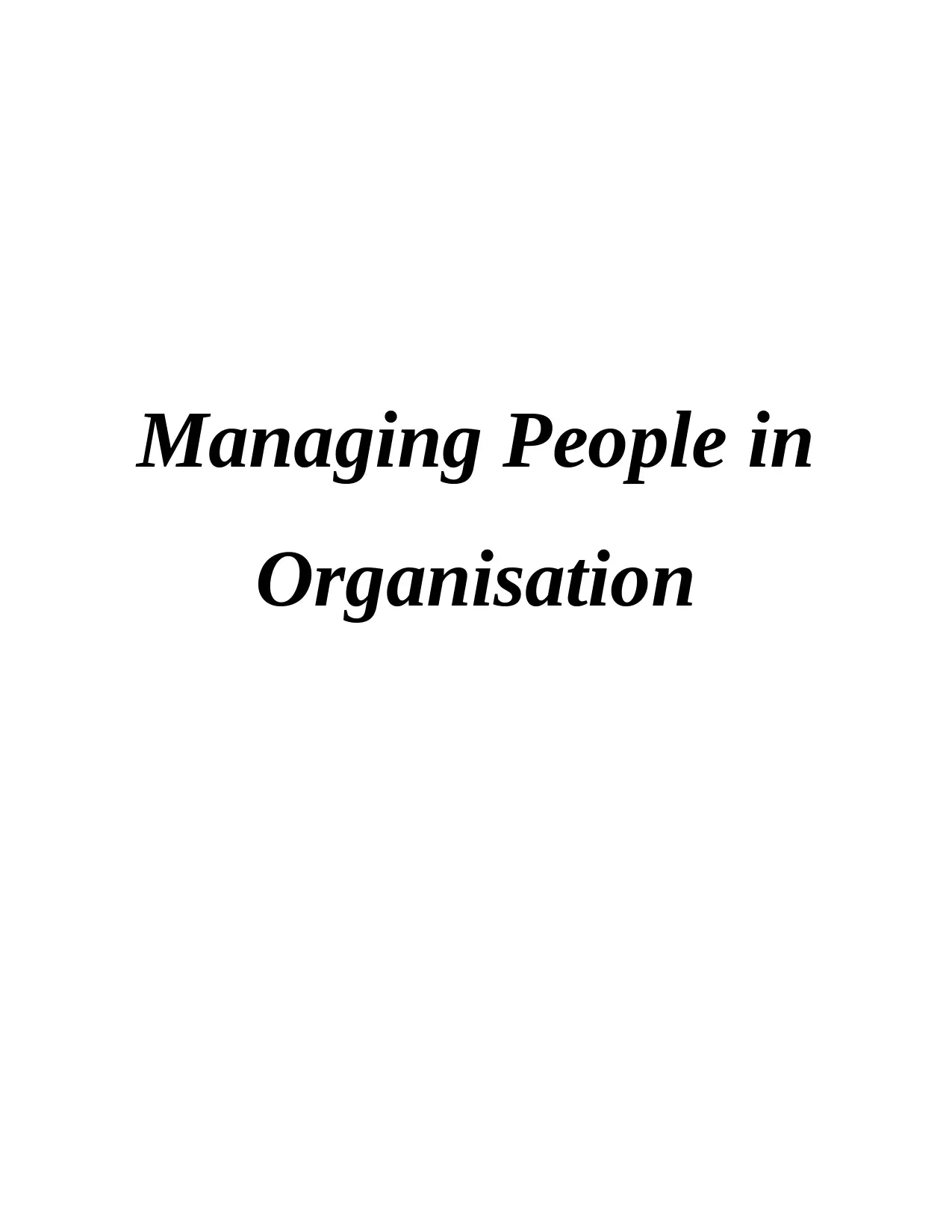
Managing People in
Organisation
Organisation
Paraphrase This Document
Need a fresh take? Get an instant paraphrase of this document with our AI Paraphraser
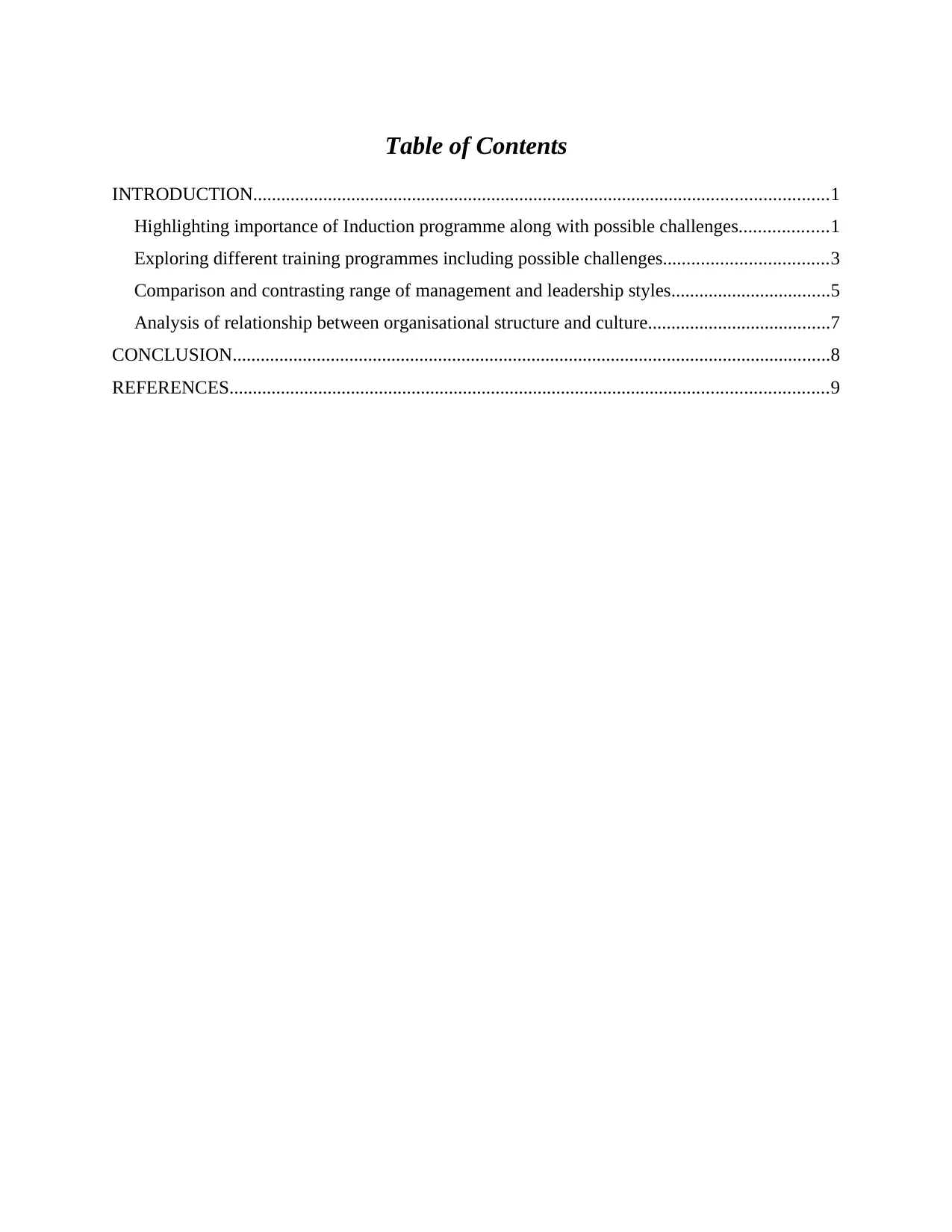
Table of Contents
INTRODUCTION...........................................................................................................................1
Highlighting importance of Induction programme along with possible challenges...................1
Exploring different training programmes including possible challenges...................................3
Comparison and contrasting range of management and leadership styles..................................5
Analysis of relationship between organisational structure and culture.......................................7
CONCLUSION................................................................................................................................8
REFERENCES................................................................................................................................9
INTRODUCTION...........................................................................................................................1
Highlighting importance of Induction programme along with possible challenges...................1
Exploring different training programmes including possible challenges...................................3
Comparison and contrasting range of management and leadership styles..................................5
Analysis of relationship between organisational structure and culture.......................................7
CONCLUSION................................................................................................................................8
REFERENCES................................................................................................................................9
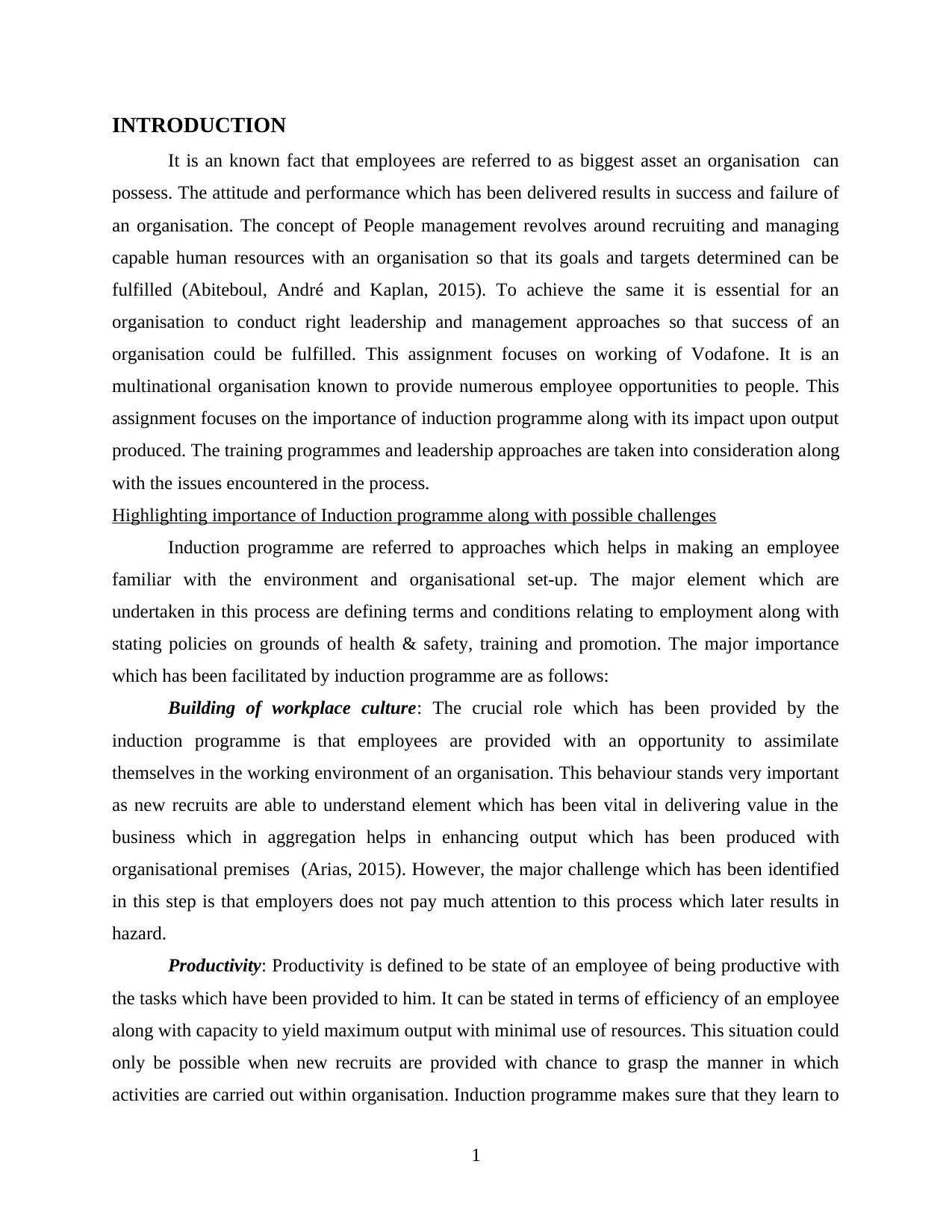
INTRODUCTION
It is an known fact that employees are referred to as biggest asset an organisation can
possess. The attitude and performance which has been delivered results in success and failure of
an organisation. The concept of People management revolves around recruiting and managing
capable human resources with an organisation so that its goals and targets determined can be
fulfilled (Abiteboul, André and Kaplan, 2015). To achieve the same it is essential for an
organisation to conduct right leadership and management approaches so that success of an
organisation could be fulfilled. This assignment focuses on working of Vodafone. It is an
multinational organisation known to provide numerous employee opportunities to people. This
assignment focuses on the importance of induction programme along with its impact upon output
produced. The training programmes and leadership approaches are taken into consideration along
with the issues encountered in the process.
Highlighting importance of Induction programme along with possible challenges
Induction programme are referred to approaches which helps in making an employee
familiar with the environment and organisational set-up. The major element which are
undertaken in this process are defining terms and conditions relating to employment along with
stating policies on grounds of health & safety, training and promotion. The major importance
which has been facilitated by induction programme are as follows:
Building of workplace culture: The crucial role which has been provided by the
induction programme is that employees are provided with an opportunity to assimilate
themselves in the working environment of an organisation. This behaviour stands very important
as new recruits are able to understand element which has been vital in delivering value in the
business which in aggregation helps in enhancing output which has been produced with
organisational premises (Arias, 2015). However, the major challenge which has been identified
in this step is that employers does not pay much attention to this process which later results in
hazard.
Productivity: Productivity is defined to be state of an employee of being productive with
the tasks which have been provided to him. It can be stated in terms of efficiency of an employee
along with capacity to yield maximum output with minimal use of resources. This situation could
only be possible when new recruits are provided with chance to grasp the manner in which
activities are carried out within organisation. Induction programme makes sure that they learn to
1
It is an known fact that employees are referred to as biggest asset an organisation can
possess. The attitude and performance which has been delivered results in success and failure of
an organisation. The concept of People management revolves around recruiting and managing
capable human resources with an organisation so that its goals and targets determined can be
fulfilled (Abiteboul, André and Kaplan, 2015). To achieve the same it is essential for an
organisation to conduct right leadership and management approaches so that success of an
organisation could be fulfilled. This assignment focuses on working of Vodafone. It is an
multinational organisation known to provide numerous employee opportunities to people. This
assignment focuses on the importance of induction programme along with its impact upon output
produced. The training programmes and leadership approaches are taken into consideration along
with the issues encountered in the process.
Highlighting importance of Induction programme along with possible challenges
Induction programme are referred to approaches which helps in making an employee
familiar with the environment and organisational set-up. The major element which are
undertaken in this process are defining terms and conditions relating to employment along with
stating policies on grounds of health & safety, training and promotion. The major importance
which has been facilitated by induction programme are as follows:
Building of workplace culture: The crucial role which has been provided by the
induction programme is that employees are provided with an opportunity to assimilate
themselves in the working environment of an organisation. This behaviour stands very important
as new recruits are able to understand element which has been vital in delivering value in the
business which in aggregation helps in enhancing output which has been produced with
organisational premises (Arias, 2015). However, the major challenge which has been identified
in this step is that employers does not pay much attention to this process which later results in
hazard.
Productivity: Productivity is defined to be state of an employee of being productive with
the tasks which have been provided to him. It can be stated in terms of efficiency of an employee
along with capacity to yield maximum output with minimal use of resources. This situation could
only be possible when new recruits are provided with chance to grasp the manner in which
activities are carried out within organisation. Induction programme makes sure that they learn to
1
⊘ This is a preview!⊘
Do you want full access?
Subscribe today to unlock all pages.

Trusted by 1+ million students worldwide
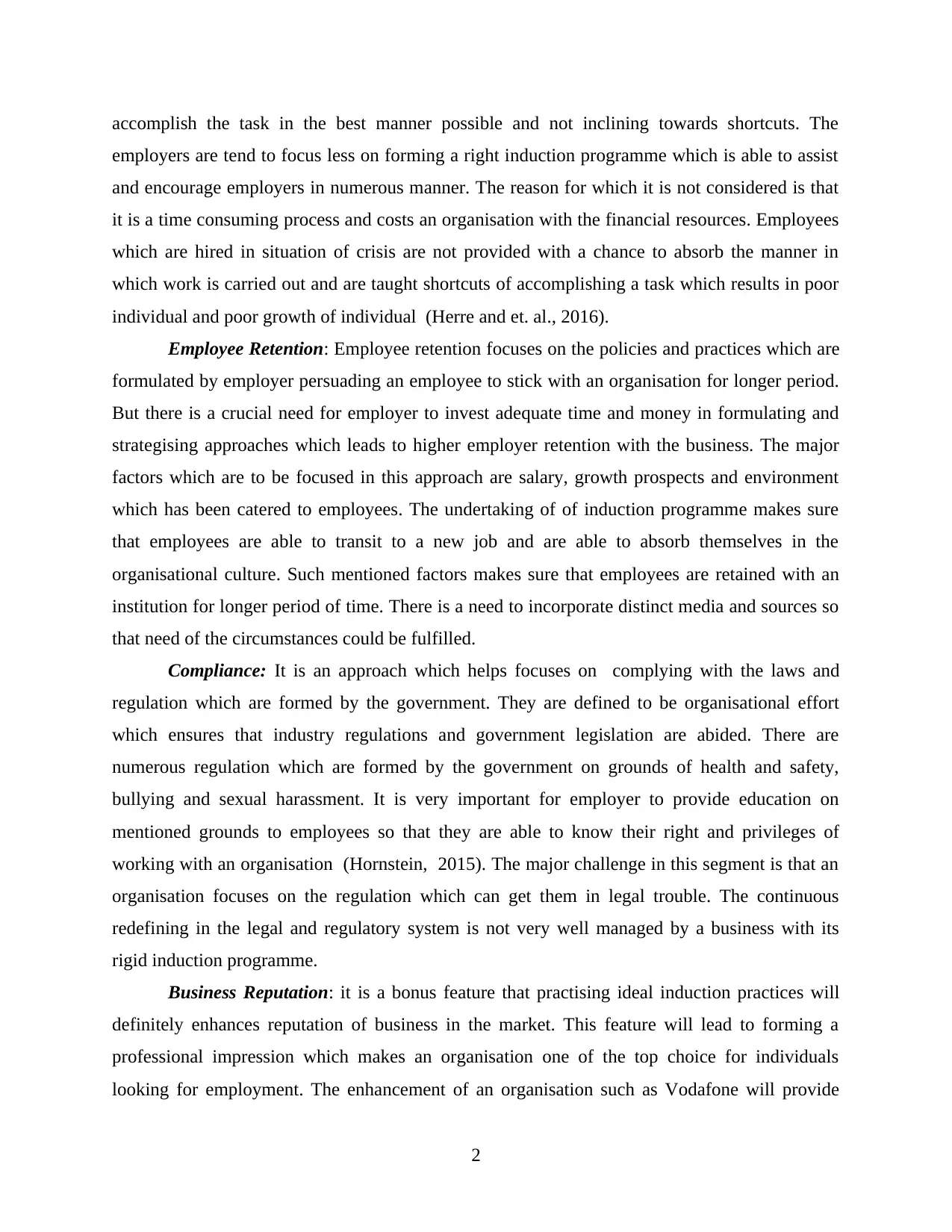
accomplish the task in the best manner possible and not inclining towards shortcuts. The
employers are tend to focus less on forming a right induction programme which is able to assist
and encourage employers in numerous manner. The reason for which it is not considered is that
it is a time consuming process and costs an organisation with the financial resources. Employees
which are hired in situation of crisis are not provided with a chance to absorb the manner in
which work is carried out and are taught shortcuts of accomplishing a task which results in poor
individual and poor growth of individual (Herre and et. al., 2016).
Employee Retention: Employee retention focuses on the policies and practices which are
formulated by employer persuading an employee to stick with an organisation for longer period.
But there is a crucial need for employer to invest adequate time and money in formulating and
strategising approaches which leads to higher employer retention with the business. The major
factors which are to be focused in this approach are salary, growth prospects and environment
which has been catered to employees. The undertaking of of induction programme makes sure
that employees are able to transit to a new job and are able to absorb themselves in the
organisational culture. Such mentioned factors makes sure that employees are retained with an
institution for longer period of time. There is a need to incorporate distinct media and sources so
that need of the circumstances could be fulfilled.
Compliance: It is an approach which helps focuses on complying with the laws and
regulation which are formed by the government. They are defined to be organisational effort
which ensures that industry regulations and government legislation are abided. There are
numerous regulation which are formed by the government on grounds of health and safety,
bullying and sexual harassment. It is very important for employer to provide education on
mentioned grounds to employees so that they are able to know their right and privileges of
working with an organisation (Hornstein, 2015). The major challenge in this segment is that an
organisation focuses on the regulation which can get them in legal trouble. The continuous
redefining in the legal and regulatory system is not very well managed by a business with its
rigid induction programme.
Business Reputation: it is a bonus feature that practising ideal induction practices will
definitely enhances reputation of business in the market. This feature will lead to forming a
professional impression which makes an organisation one of the top choice for individuals
looking for employment. The enhancement of an organisation such as Vodafone will provide
2
employers are tend to focus less on forming a right induction programme which is able to assist
and encourage employers in numerous manner. The reason for which it is not considered is that
it is a time consuming process and costs an organisation with the financial resources. Employees
which are hired in situation of crisis are not provided with a chance to absorb the manner in
which work is carried out and are taught shortcuts of accomplishing a task which results in poor
individual and poor growth of individual (Herre and et. al., 2016).
Employee Retention: Employee retention focuses on the policies and practices which are
formulated by employer persuading an employee to stick with an organisation for longer period.
But there is a crucial need for employer to invest adequate time and money in formulating and
strategising approaches which leads to higher employer retention with the business. The major
factors which are to be focused in this approach are salary, growth prospects and environment
which has been catered to employees. The undertaking of of induction programme makes sure
that employees are able to transit to a new job and are able to absorb themselves in the
organisational culture. Such mentioned factors makes sure that employees are retained with an
institution for longer period of time. There is a need to incorporate distinct media and sources so
that need of the circumstances could be fulfilled.
Compliance: It is an approach which helps focuses on complying with the laws and
regulation which are formed by the government. They are defined to be organisational effort
which ensures that industry regulations and government legislation are abided. There are
numerous regulation which are formed by the government on grounds of health and safety,
bullying and sexual harassment. It is very important for employer to provide education on
mentioned grounds to employees so that they are able to know their right and privileges of
working with an organisation (Hornstein, 2015). The major challenge in this segment is that an
organisation focuses on the regulation which can get them in legal trouble. The continuous
redefining in the legal and regulatory system is not very well managed by a business with its
rigid induction programme.
Business Reputation: it is a bonus feature that practising ideal induction practices will
definitely enhances reputation of business in the market. This feature will lead to forming a
professional impression which makes an organisation one of the top choice for individuals
looking for employment. The enhancement of an organisation such as Vodafone will provide
2
Paraphrase This Document
Need a fresh take? Get an instant paraphrase of this document with our AI Paraphraser
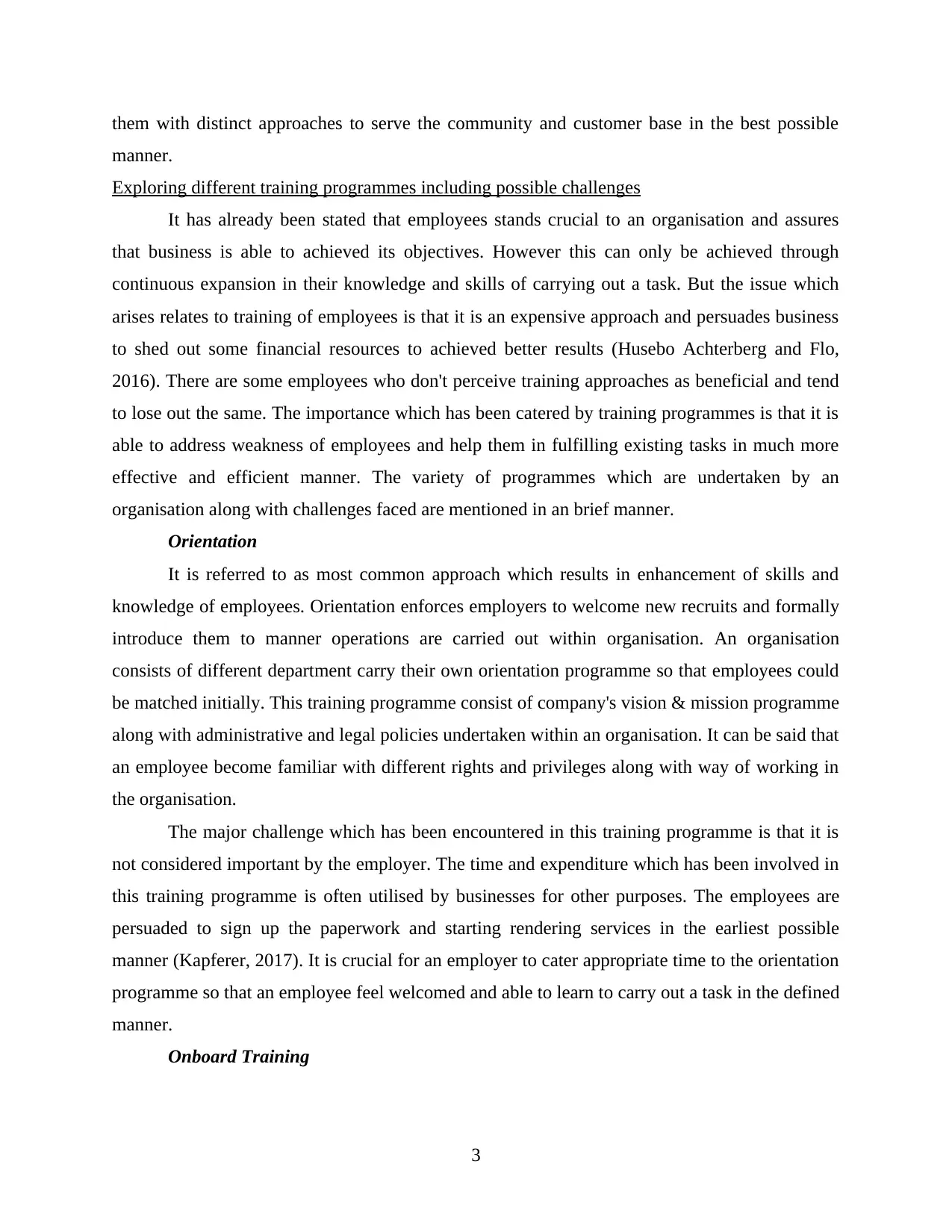
them with distinct approaches to serve the community and customer base in the best possible
manner.
Exploring different training programmes including possible challenges
It has already been stated that employees stands crucial to an organisation and assures
that business is able to achieved its objectives. However this can only be achieved through
continuous expansion in their knowledge and skills of carrying out a task. But the issue which
arises relates to training of employees is that it is an expensive approach and persuades business
to shed out some financial resources to achieved better results (Husebo Achterberg and Flo,
2016). There are some employees who don't perceive training approaches as beneficial and tend
to lose out the same. The importance which has been catered by training programmes is that it is
able to address weakness of employees and help them in fulfilling existing tasks in much more
effective and efficient manner. The variety of programmes which are undertaken by an
organisation along with challenges faced are mentioned in an brief manner.
Orientation
It is referred to as most common approach which results in enhancement of skills and
knowledge of employees. Orientation enforces employers to welcome new recruits and formally
introduce them to manner operations are carried out within organisation. An organisation
consists of different department carry their own orientation programme so that employees could
be matched initially. This training programme consist of company's vision & mission programme
along with administrative and legal policies undertaken within an organisation. It can be said that
an employee become familiar with different rights and privileges along with way of working in
the organisation.
The major challenge which has been encountered in this training programme is that it is
not considered important by the employer. The time and expenditure which has been involved in
this training programme is often utilised by businesses for other purposes. The employees are
persuaded to sign up the paperwork and starting rendering services in the earliest possible
manner (Kapferer, 2017). It is crucial for an employer to cater appropriate time to the orientation
programme so that an employee feel welcomed and able to learn to carry out a task in the defined
manner.
Onboard Training
3
manner.
Exploring different training programmes including possible challenges
It has already been stated that employees stands crucial to an organisation and assures
that business is able to achieved its objectives. However this can only be achieved through
continuous expansion in their knowledge and skills of carrying out a task. But the issue which
arises relates to training of employees is that it is an expensive approach and persuades business
to shed out some financial resources to achieved better results (Husebo Achterberg and Flo,
2016). There are some employees who don't perceive training approaches as beneficial and tend
to lose out the same. The importance which has been catered by training programmes is that it is
able to address weakness of employees and help them in fulfilling existing tasks in much more
effective and efficient manner. The variety of programmes which are undertaken by an
organisation along with challenges faced are mentioned in an brief manner.
Orientation
It is referred to as most common approach which results in enhancement of skills and
knowledge of employees. Orientation enforces employers to welcome new recruits and formally
introduce them to manner operations are carried out within organisation. An organisation
consists of different department carry their own orientation programme so that employees could
be matched initially. This training programme consist of company's vision & mission programme
along with administrative and legal policies undertaken within an organisation. It can be said that
an employee become familiar with different rights and privileges along with way of working in
the organisation.
The major challenge which has been encountered in this training programme is that it is
not considered important by the employer. The time and expenditure which has been involved in
this training programme is often utilised by businesses for other purposes. The employees are
persuaded to sign up the paperwork and starting rendering services in the earliest possible
manner (Kapferer, 2017). It is crucial for an employer to cater appropriate time to the orientation
programme so that an employee feel welcomed and able to learn to carry out a task in the defined
manner.
Onboard Training
3
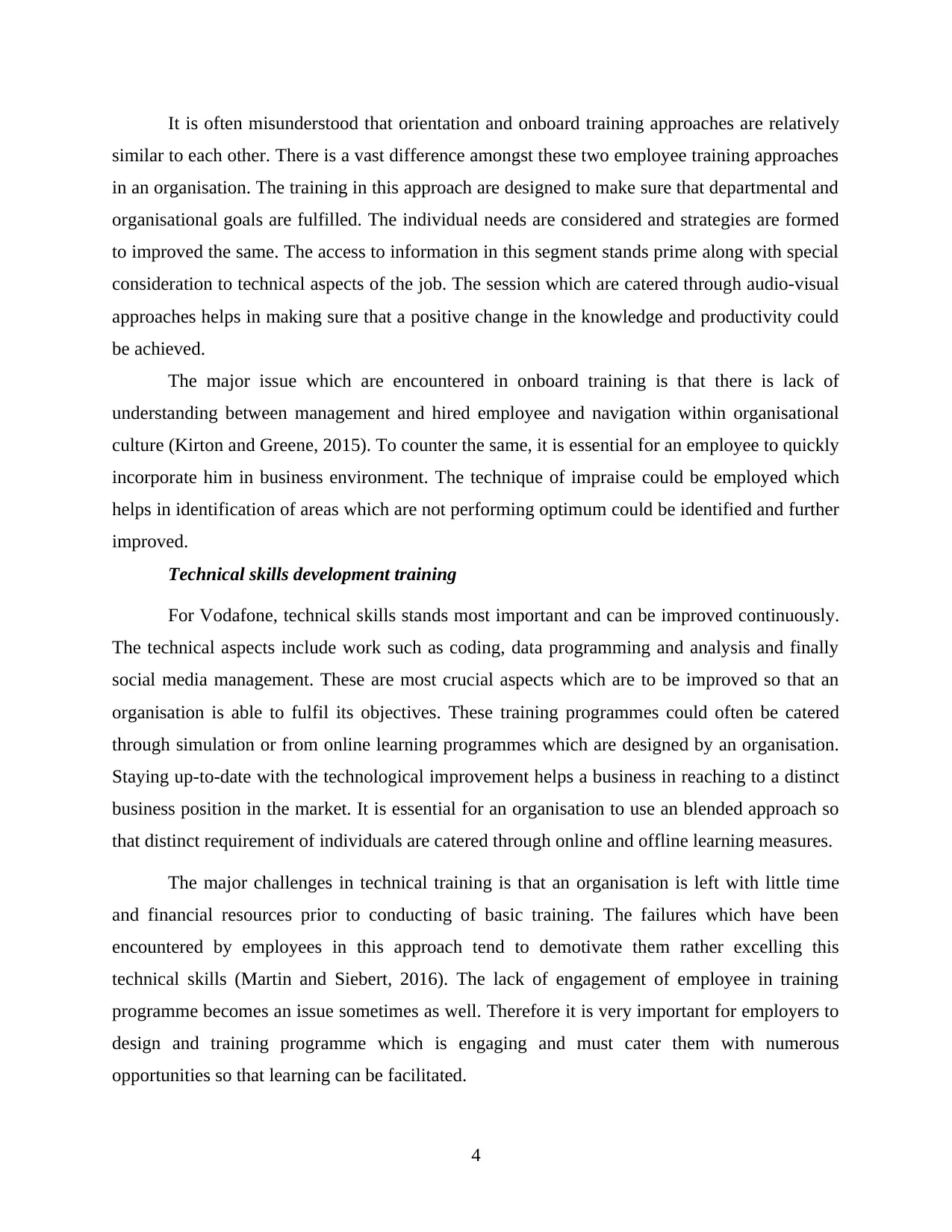
It is often misunderstood that orientation and onboard training approaches are relatively
similar to each other. There is a vast difference amongst these two employee training approaches
in an organisation. The training in this approach are designed to make sure that departmental and
organisational goals are fulfilled. The individual needs are considered and strategies are formed
to improved the same. The access to information in this segment stands prime along with special
consideration to technical aspects of the job. The session which are catered through audio-visual
approaches helps in making sure that a positive change in the knowledge and productivity could
be achieved.
The major issue which are encountered in onboard training is that there is lack of
understanding between management and hired employee and navigation within organisational
culture (Kirton and Greene, 2015). To counter the same, it is essential for an employee to quickly
incorporate him in business environment. The technique of impraise could be employed which
helps in identification of areas which are not performing optimum could be identified and further
improved.
Technical skills development training
For Vodafone, technical skills stands most important and can be improved continuously.
The technical aspects include work such as coding, data programming and analysis and finally
social media management. These are most crucial aspects which are to be improved so that an
organisation is able to fulfil its objectives. These training programmes could often be catered
through simulation or from online learning programmes which are designed by an organisation.
Staying up-to-date with the technological improvement helps a business in reaching to a distinct
business position in the market. It is essential for an organisation to use an blended approach so
that distinct requirement of individuals are catered through online and offline learning measures.
The major challenges in technical training is that an organisation is left with little time
and financial resources prior to conducting of basic training. The failures which have been
encountered by employees in this approach tend to demotivate them rather excelling this
technical skills (Martin and Siebert, 2016). The lack of engagement of employee in training
programme becomes an issue sometimes as well. Therefore it is very important for employers to
design and training programme which is engaging and must cater them with numerous
opportunities so that learning can be facilitated.
4
similar to each other. There is a vast difference amongst these two employee training approaches
in an organisation. The training in this approach are designed to make sure that departmental and
organisational goals are fulfilled. The individual needs are considered and strategies are formed
to improved the same. The access to information in this segment stands prime along with special
consideration to technical aspects of the job. The session which are catered through audio-visual
approaches helps in making sure that a positive change in the knowledge and productivity could
be achieved.
The major issue which are encountered in onboard training is that there is lack of
understanding between management and hired employee and navigation within organisational
culture (Kirton and Greene, 2015). To counter the same, it is essential for an employee to quickly
incorporate him in business environment. The technique of impraise could be employed which
helps in identification of areas which are not performing optimum could be identified and further
improved.
Technical skills development training
For Vodafone, technical skills stands most important and can be improved continuously.
The technical aspects include work such as coding, data programming and analysis and finally
social media management. These are most crucial aspects which are to be improved so that an
organisation is able to fulfil its objectives. These training programmes could often be catered
through simulation or from online learning programmes which are designed by an organisation.
Staying up-to-date with the technological improvement helps a business in reaching to a distinct
business position in the market. It is essential for an organisation to use an blended approach so
that distinct requirement of individuals are catered through online and offline learning measures.
The major challenges in technical training is that an organisation is left with little time
and financial resources prior to conducting of basic training. The failures which have been
encountered by employees in this approach tend to demotivate them rather excelling this
technical skills (Martin and Siebert, 2016). The lack of engagement of employee in training
programme becomes an issue sometimes as well. Therefore it is very important for employers to
design and training programme which is engaging and must cater them with numerous
opportunities so that learning can be facilitated.
4
⊘ This is a preview!⊘
Do you want full access?
Subscribe today to unlock all pages.

Trusted by 1+ million students worldwide
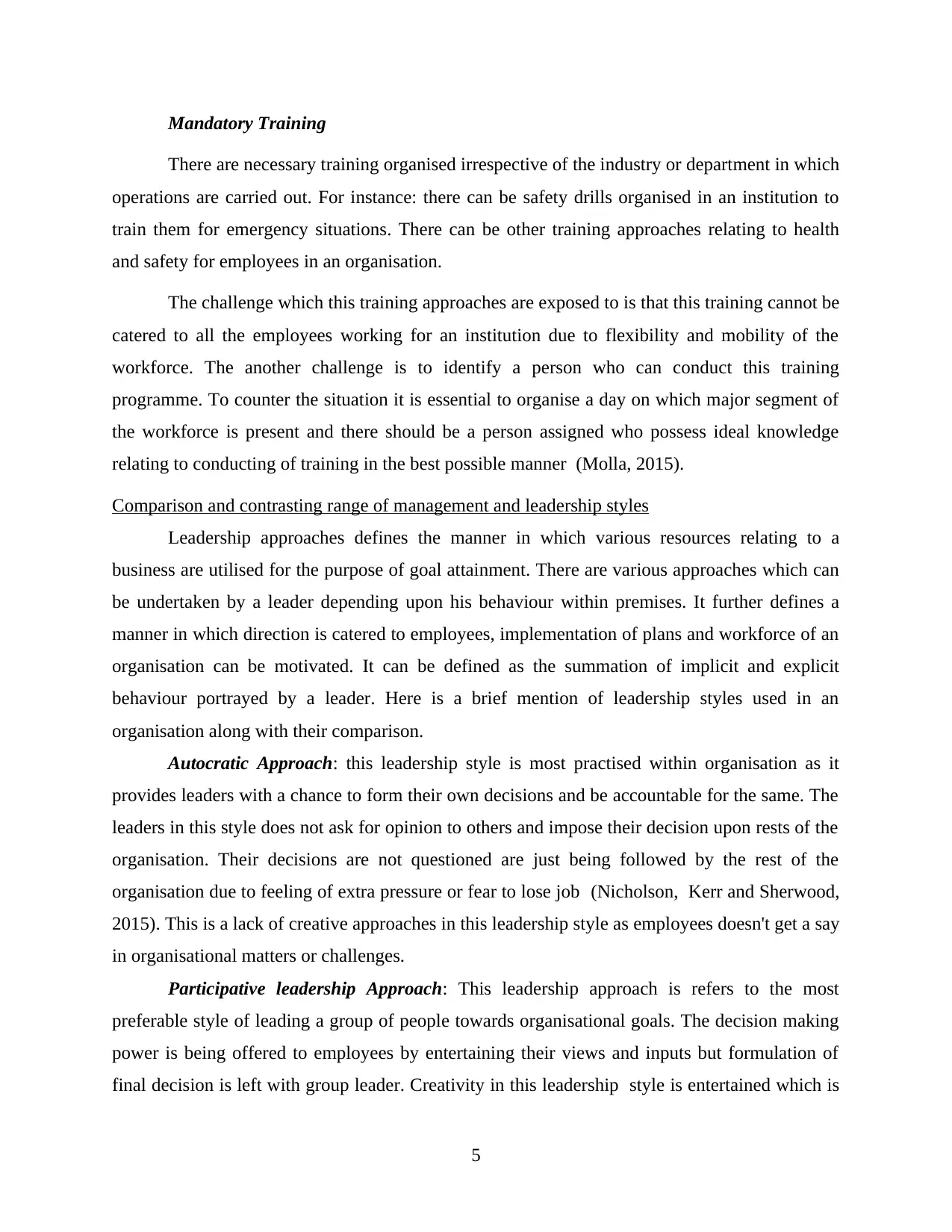
Mandatory Training
There are necessary training organised irrespective of the industry or department in which
operations are carried out. For instance: there can be safety drills organised in an institution to
train them for emergency situations. There can be other training approaches relating to health
and safety for employees in an organisation.
The challenge which this training approaches are exposed to is that this training cannot be
catered to all the employees working for an institution due to flexibility and mobility of the
workforce. The another challenge is to identify a person who can conduct this training
programme. To counter the situation it is essential to organise a day on which major segment of
the workforce is present and there should be a person assigned who possess ideal knowledge
relating to conducting of training in the best possible manner (Molla, 2015).
Comparison and contrasting range of management and leadership styles
Leadership approaches defines the manner in which various resources relating to a
business are utilised for the purpose of goal attainment. There are various approaches which can
be undertaken by a leader depending upon his behaviour within premises. It further defines a
manner in which direction is catered to employees, implementation of plans and workforce of an
organisation can be motivated. It can be defined as the summation of implicit and explicit
behaviour portrayed by a leader. Here is a brief mention of leadership styles used in an
organisation along with their comparison.
Autocratic Approach: this leadership style is most practised within organisation as it
provides leaders with a chance to form their own decisions and be accountable for the same. The
leaders in this style does not ask for opinion to others and impose their decision upon rests of the
organisation. Their decisions are not questioned are just being followed by the rest of the
organisation due to feeling of extra pressure or fear to lose job (Nicholson, Kerr and Sherwood,
2015). This is a lack of creative approaches in this leadership style as employees doesn't get a say
in organisational matters or challenges.
Participative leadership Approach: This leadership approach is refers to the most
preferable style of leading a group of people towards organisational goals. The decision making
power is being offered to employees by entertaining their views and inputs but formulation of
final decision is left with group leader. Creativity in this leadership style is entertained which is
5
There are necessary training organised irrespective of the industry or department in which
operations are carried out. For instance: there can be safety drills organised in an institution to
train them for emergency situations. There can be other training approaches relating to health
and safety for employees in an organisation.
The challenge which this training approaches are exposed to is that this training cannot be
catered to all the employees working for an institution due to flexibility and mobility of the
workforce. The another challenge is to identify a person who can conduct this training
programme. To counter the situation it is essential to organise a day on which major segment of
the workforce is present and there should be a person assigned who possess ideal knowledge
relating to conducting of training in the best possible manner (Molla, 2015).
Comparison and contrasting range of management and leadership styles
Leadership approaches defines the manner in which various resources relating to a
business are utilised for the purpose of goal attainment. There are various approaches which can
be undertaken by a leader depending upon his behaviour within premises. It further defines a
manner in which direction is catered to employees, implementation of plans and workforce of an
organisation can be motivated. It can be defined as the summation of implicit and explicit
behaviour portrayed by a leader. Here is a brief mention of leadership styles used in an
organisation along with their comparison.
Autocratic Approach: this leadership style is most practised within organisation as it
provides leaders with a chance to form their own decisions and be accountable for the same. The
leaders in this style does not ask for opinion to others and impose their decision upon rests of the
organisation. Their decisions are not questioned are just being followed by the rest of the
organisation due to feeling of extra pressure or fear to lose job (Nicholson, Kerr and Sherwood,
2015). This is a lack of creative approaches in this leadership style as employees doesn't get a say
in organisational matters or challenges.
Participative leadership Approach: This leadership approach is refers to the most
preferable style of leading a group of people towards organisational goals. The decision making
power is being offered to employees by entertaining their views and inputs but formulation of
final decision is left with group leader. Creativity in this leadership style is entertained which is
5
Paraphrase This Document
Need a fresh take? Get an instant paraphrase of this document with our AI Paraphraser
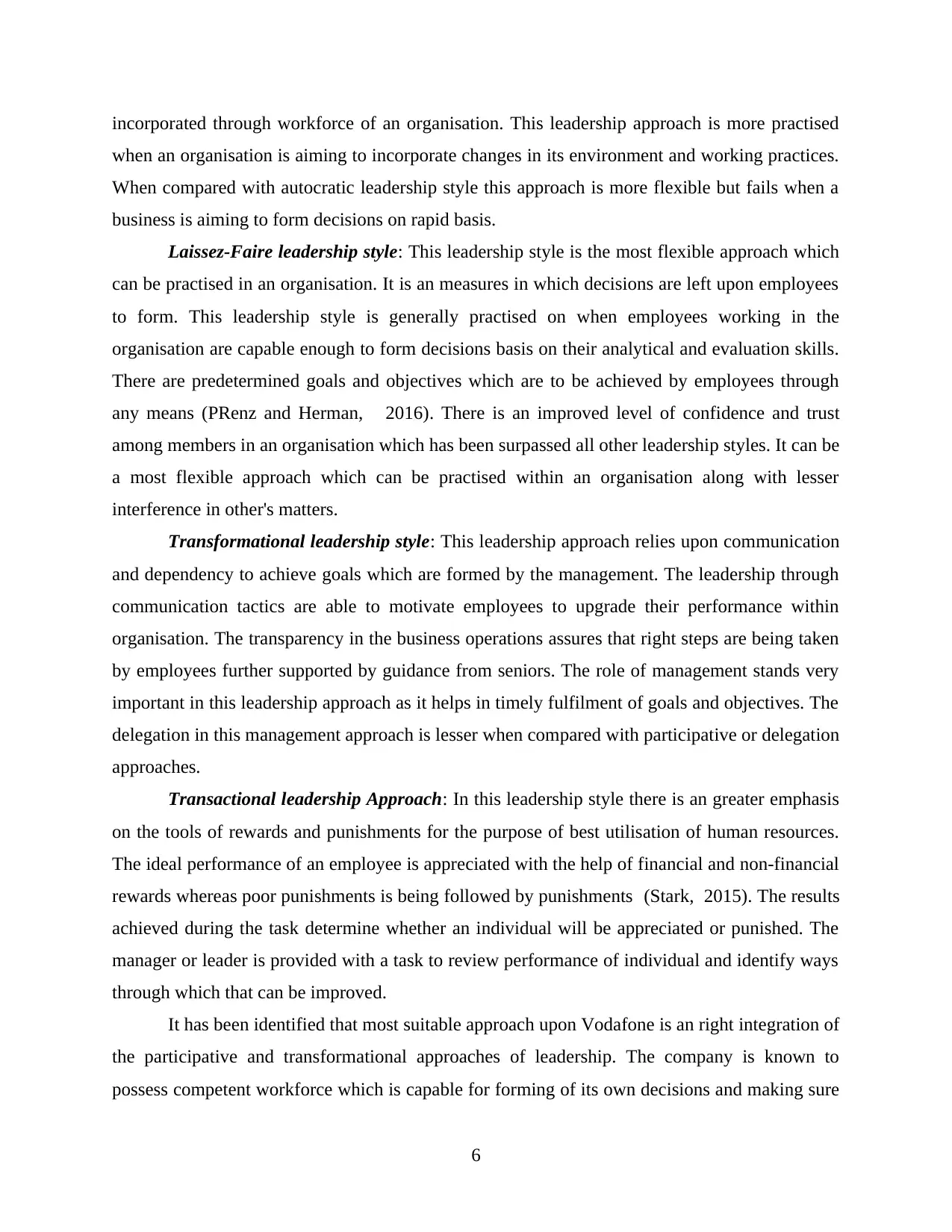
incorporated through workforce of an organisation. This leadership approach is more practised
when an organisation is aiming to incorporate changes in its environment and working practices.
When compared with autocratic leadership style this approach is more flexible but fails when a
business is aiming to form decisions on rapid basis.
Laissez-Faire leadership style: This leadership style is the most flexible approach which
can be practised in an organisation. It is an measures in which decisions are left upon employees
to form. This leadership style is generally practised on when employees working in the
organisation are capable enough to form decisions basis on their analytical and evaluation skills.
There are predetermined goals and objectives which are to be achieved by employees through
any means (PRenz and Herman, 2016). There is an improved level of confidence and trust
among members in an organisation which has been surpassed all other leadership styles. It can be
a most flexible approach which can be practised within an organisation along with lesser
interference in other's matters.
Transformational leadership style: This leadership approach relies upon communication
and dependency to achieve goals which are formed by the management. The leadership through
communication tactics are able to motivate employees to upgrade their performance within
organisation. The transparency in the business operations assures that right steps are being taken
by employees further supported by guidance from seniors. The role of management stands very
important in this leadership approach as it helps in timely fulfilment of goals and objectives. The
delegation in this management approach is lesser when compared with participative or delegation
approaches.
Transactional leadership Approach: In this leadership style there is an greater emphasis
on the tools of rewards and punishments for the purpose of best utilisation of human resources.
The ideal performance of an employee is appreciated with the help of financial and non-financial
rewards whereas poor punishments is being followed by punishments (Stark, 2015). The results
achieved during the task determine whether an individual will be appreciated or punished. The
manager or leader is provided with a task to review performance of individual and identify ways
through which that can be improved.
It has been identified that most suitable approach upon Vodafone is an right integration of
the participative and transformational approaches of leadership. The company is known to
possess competent workforce which is capable for forming of its own decisions and making sure
6
when an organisation is aiming to incorporate changes in its environment and working practices.
When compared with autocratic leadership style this approach is more flexible but fails when a
business is aiming to form decisions on rapid basis.
Laissez-Faire leadership style: This leadership style is the most flexible approach which
can be practised in an organisation. It is an measures in which decisions are left upon employees
to form. This leadership style is generally practised on when employees working in the
organisation are capable enough to form decisions basis on their analytical and evaluation skills.
There are predetermined goals and objectives which are to be achieved by employees through
any means (PRenz and Herman, 2016). There is an improved level of confidence and trust
among members in an organisation which has been surpassed all other leadership styles. It can be
a most flexible approach which can be practised within an organisation along with lesser
interference in other's matters.
Transformational leadership style: This leadership approach relies upon communication
and dependency to achieve goals which are formed by the management. The leadership through
communication tactics are able to motivate employees to upgrade their performance within
organisation. The transparency in the business operations assures that right steps are being taken
by employees further supported by guidance from seniors. The role of management stands very
important in this leadership approach as it helps in timely fulfilment of goals and objectives. The
delegation in this management approach is lesser when compared with participative or delegation
approaches.
Transactional leadership Approach: In this leadership style there is an greater emphasis
on the tools of rewards and punishments for the purpose of best utilisation of human resources.
The ideal performance of an employee is appreciated with the help of financial and non-financial
rewards whereas poor punishments is being followed by punishments (Stark, 2015). The results
achieved during the task determine whether an individual will be appreciated or punished. The
manager or leader is provided with a task to review performance of individual and identify ways
through which that can be improved.
It has been identified that most suitable approach upon Vodafone is an right integration of
the participative and transformational approaches of leadership. The company is known to
possess competent workforce which is capable for forming of its own decisions and making sure
6
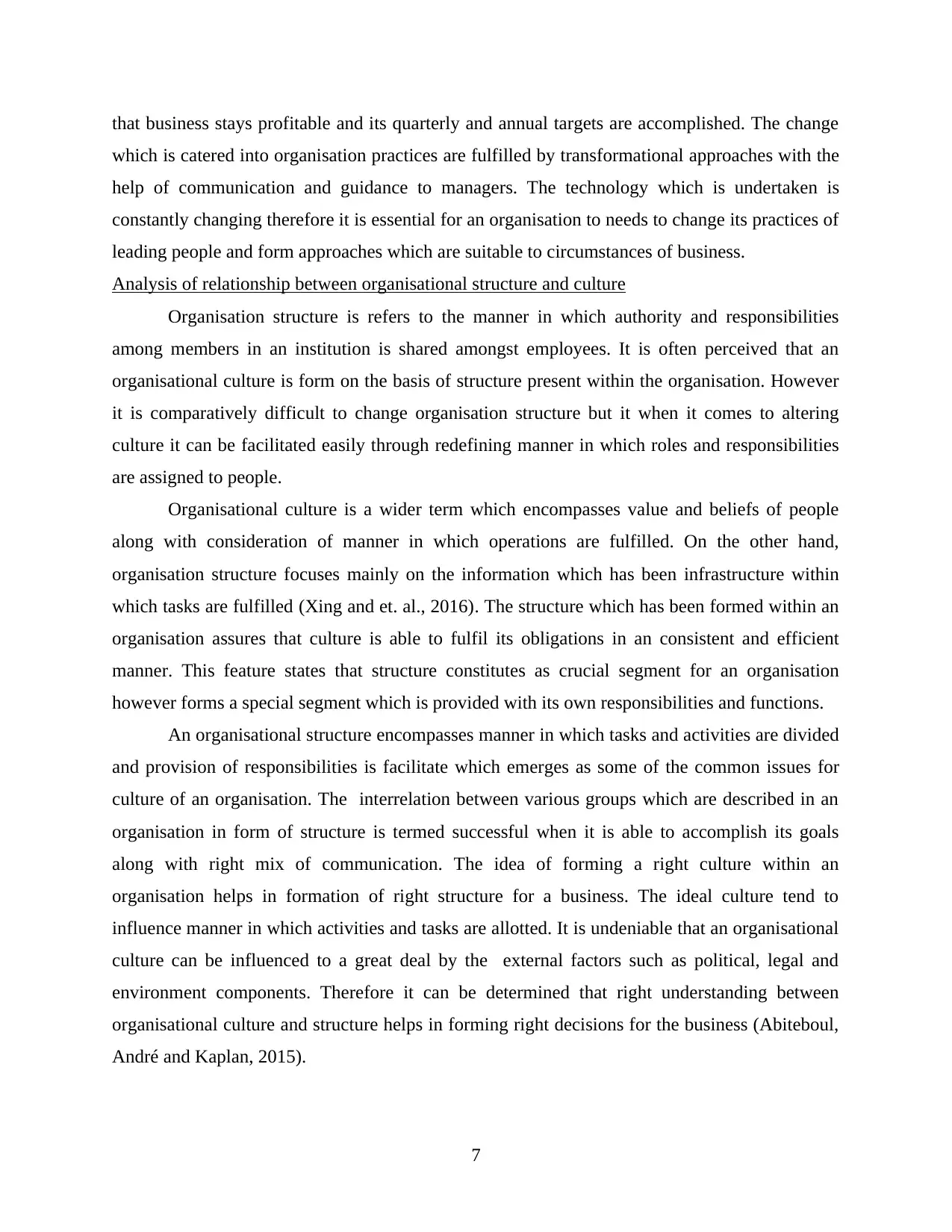
that business stays profitable and its quarterly and annual targets are accomplished. The change
which is catered into organisation practices are fulfilled by transformational approaches with the
help of communication and guidance to managers. The technology which is undertaken is
constantly changing therefore it is essential for an organisation to needs to change its practices of
leading people and form approaches which are suitable to circumstances of business.
Analysis of relationship between organisational structure and culture
Organisation structure is refers to the manner in which authority and responsibilities
among members in an institution is shared amongst employees. It is often perceived that an
organisational culture is form on the basis of structure present within the organisation. However
it is comparatively difficult to change organisation structure but it when it comes to altering
culture it can be facilitated easily through redefining manner in which roles and responsibilities
are assigned to people.
Organisational culture is a wider term which encompasses value and beliefs of people
along with consideration of manner in which operations are fulfilled. On the other hand,
organisation structure focuses mainly on the information which has been infrastructure within
which tasks are fulfilled (Xing and et. al., 2016). The structure which has been formed within an
organisation assures that culture is able to fulfil its obligations in an consistent and efficient
manner. This feature states that structure constitutes as crucial segment for an organisation
however forms a special segment which is provided with its own responsibilities and functions.
An organisational structure encompasses manner in which tasks and activities are divided
and provision of responsibilities is facilitate which emerges as some of the common issues for
culture of an organisation. The interrelation between various groups which are described in an
organisation in form of structure is termed successful when it is able to accomplish its goals
along with right mix of communication. The idea of forming a right culture within an
organisation helps in formation of right structure for a business. The ideal culture tend to
influence manner in which activities and tasks are allotted. It is undeniable that an organisational
culture can be influenced to a great deal by the external factors such as political, legal and
environment components. Therefore it can be determined that right understanding between
organisational culture and structure helps in forming right decisions for the business (Abiteboul,
André and Kaplan, 2015).
7
which is catered into organisation practices are fulfilled by transformational approaches with the
help of communication and guidance to managers. The technology which is undertaken is
constantly changing therefore it is essential for an organisation to needs to change its practices of
leading people and form approaches which are suitable to circumstances of business.
Analysis of relationship between organisational structure and culture
Organisation structure is refers to the manner in which authority and responsibilities
among members in an institution is shared amongst employees. It is often perceived that an
organisational culture is form on the basis of structure present within the organisation. However
it is comparatively difficult to change organisation structure but it when it comes to altering
culture it can be facilitated easily through redefining manner in which roles and responsibilities
are assigned to people.
Organisational culture is a wider term which encompasses value and beliefs of people
along with consideration of manner in which operations are fulfilled. On the other hand,
organisation structure focuses mainly on the information which has been infrastructure within
which tasks are fulfilled (Xing and et. al., 2016). The structure which has been formed within an
organisation assures that culture is able to fulfil its obligations in an consistent and efficient
manner. This feature states that structure constitutes as crucial segment for an organisation
however forms a special segment which is provided with its own responsibilities and functions.
An organisational structure encompasses manner in which tasks and activities are divided
and provision of responsibilities is facilitate which emerges as some of the common issues for
culture of an organisation. The interrelation between various groups which are described in an
organisation in form of structure is termed successful when it is able to accomplish its goals
along with right mix of communication. The idea of forming a right culture within an
organisation helps in formation of right structure for a business. The ideal culture tend to
influence manner in which activities and tasks are allotted. It is undeniable that an organisational
culture can be influenced to a great deal by the external factors such as political, legal and
environment components. Therefore it can be determined that right understanding between
organisational culture and structure helps in forming right decisions for the business (Abiteboul,
André and Kaplan, 2015).
7
⊘ This is a preview!⊘
Do you want full access?
Subscribe today to unlock all pages.

Trusted by 1+ million students worldwide
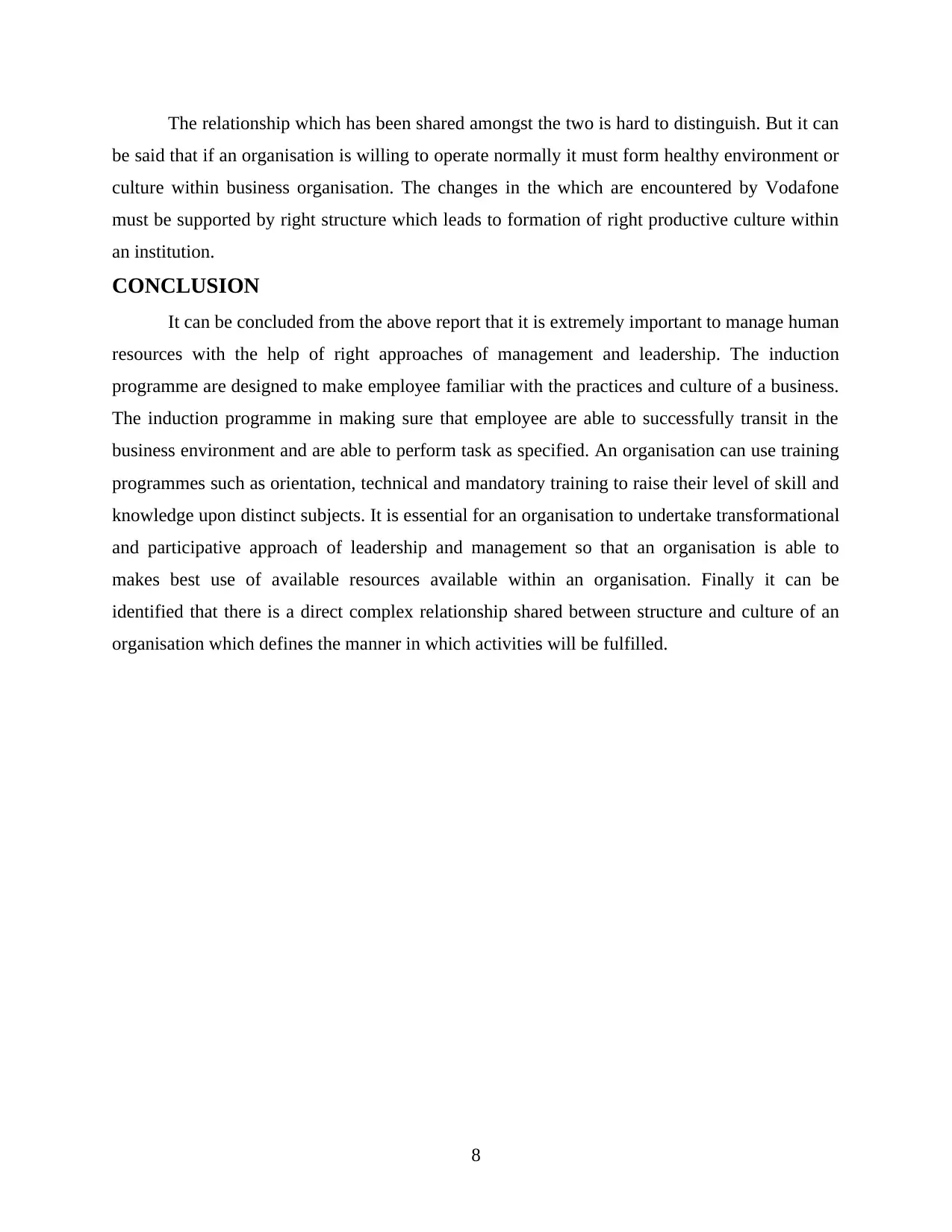
The relationship which has been shared amongst the two is hard to distinguish. But it can
be said that if an organisation is willing to operate normally it must form healthy environment or
culture within business organisation. The changes in the which are encountered by Vodafone
must be supported by right structure which leads to formation of right productive culture within
an institution.
CONCLUSION
It can be concluded from the above report that it is extremely important to manage human
resources with the help of right approaches of management and leadership. The induction
programme are designed to make employee familiar with the practices and culture of a business.
The induction programme in making sure that employee are able to successfully transit in the
business environment and are able to perform task as specified. An organisation can use training
programmes such as orientation, technical and mandatory training to raise their level of skill and
knowledge upon distinct subjects. It is essential for an organisation to undertake transformational
and participative approach of leadership and management so that an organisation is able to
makes best use of available resources available within an organisation. Finally it can be
identified that there is a direct complex relationship shared between structure and culture of an
organisation which defines the manner in which activities will be fulfilled.
8
be said that if an organisation is willing to operate normally it must form healthy environment or
culture within business organisation. The changes in the which are encountered by Vodafone
must be supported by right structure which leads to formation of right productive culture within
an institution.
CONCLUSION
It can be concluded from the above report that it is extremely important to manage human
resources with the help of right approaches of management and leadership. The induction
programme are designed to make employee familiar with the practices and culture of a business.
The induction programme in making sure that employee are able to successfully transit in the
business environment and are able to perform task as specified. An organisation can use training
programmes such as orientation, technical and mandatory training to raise their level of skill and
knowledge upon distinct subjects. It is essential for an organisation to undertake transformational
and participative approach of leadership and management so that an organisation is able to
makes best use of available resources available within an organisation. Finally it can be
identified that there is a direct complex relationship shared between structure and culture of an
organisation which defines the manner in which activities will be fulfilled.
8
Paraphrase This Document
Need a fresh take? Get an instant paraphrase of this document with our AI Paraphraser
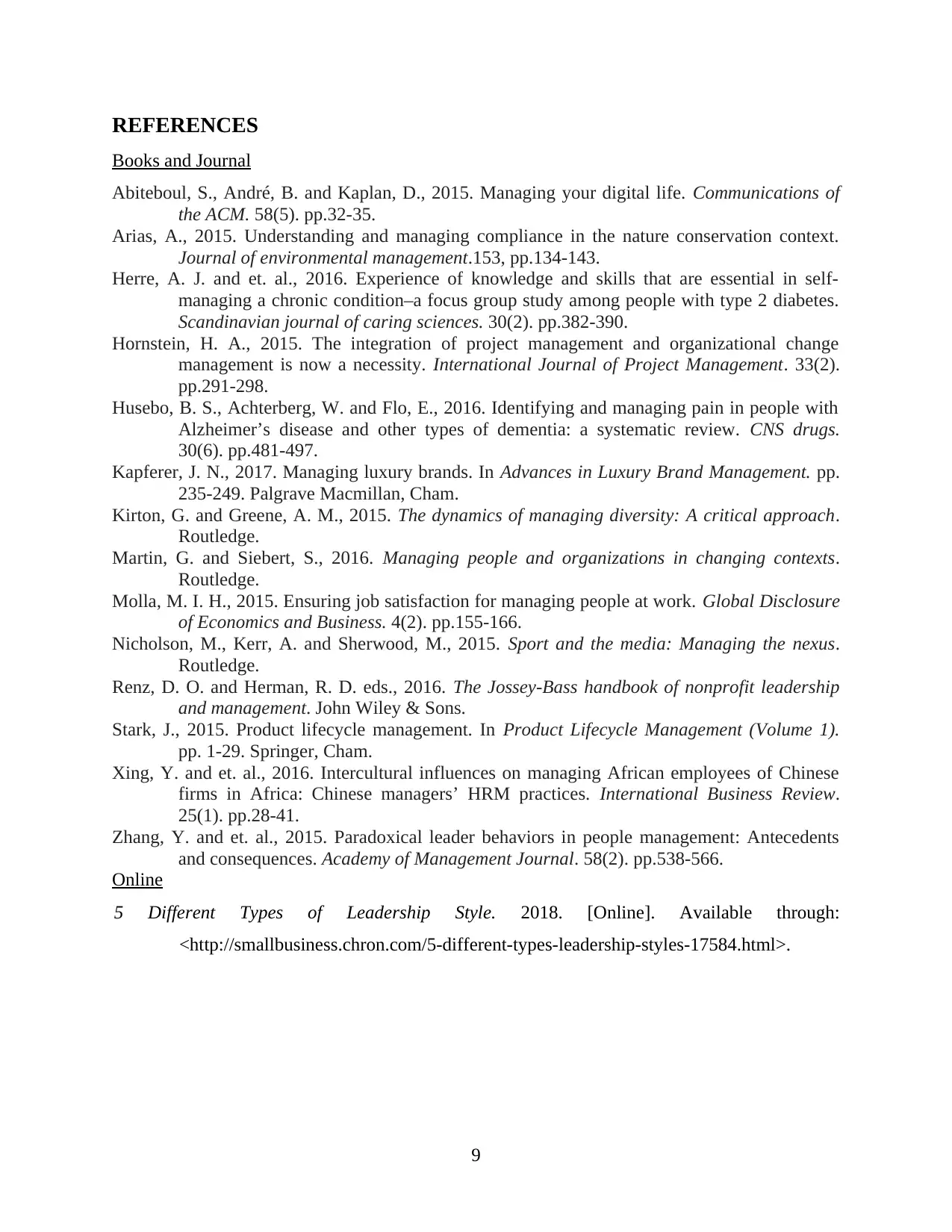
REFERENCES
Books and Journal
Abiteboul, S., André, B. and Kaplan, D., 2015. Managing your digital life. Communications of
the ACM. 58(5). pp.32-35.
Arias, A., 2015. Understanding and managing compliance in the nature conservation context.
Journal of environmental management.153, pp.134-143.
Herre, A. J. and et. al., 2016. Experience of knowledge and skills that are essential in self‐
managing a chronic condition–a focus group study among people with type 2 diabetes.
Scandinavian journal of caring sciences. 30(2). pp.382-390.
Hornstein, H. A., 2015. The integration of project management and organizational change
management is now a necessity. International Journal of Project Management. 33(2).
pp.291-298.
Husebo, B. S., Achterberg, W. and Flo, E., 2016. Identifying and managing pain in people with
Alzheimer’s disease and other types of dementia: a systematic review. CNS drugs.
30(6). pp.481-497.
Kapferer, J. N., 2017. Managing luxury brands. In Advances in Luxury Brand Management. pp.
235-249. Palgrave Macmillan, Cham.
Kirton, G. and Greene, A. M., 2015. The dynamics of managing diversity: A critical approach.
Routledge.
Martin, G. and Siebert, S., 2016. Managing people and organizations in changing contexts.
Routledge.
Molla, M. I. H., 2015. Ensuring job satisfaction for managing people at work. Global Disclosure
of Economics and Business. 4(2). pp.155-166.
Nicholson, M., Kerr, A. and Sherwood, M., 2015. Sport and the media: Managing the nexus.
Routledge.
Renz, D. O. and Herman, R. D. eds., 2016. The Jossey-Bass handbook of nonprofit leadership
and management. John Wiley & Sons.
Stark, J., 2015. Product lifecycle management. In Product Lifecycle Management (Volume 1).
pp. 1-29. Springer, Cham.
Xing, Y. and et. al., 2016. Intercultural influences on managing African employees of Chinese
firms in Africa: Chinese managers’ HRM practices. International Business Review.
25(1). pp.28-41.
Zhang, Y. and et. al., 2015. Paradoxical leader behaviors in people management: Antecedents
and consequences. Academy of Management Journal. 58(2). pp.538-566.
Online
5 Different Types of Leadership Style. 2018. [Online]. Available through:
<http://smallbusiness.chron.com/5-different-types-leadership-styles-17584.html>.
9
Books and Journal
Abiteboul, S., André, B. and Kaplan, D., 2015. Managing your digital life. Communications of
the ACM. 58(5). pp.32-35.
Arias, A., 2015. Understanding and managing compliance in the nature conservation context.
Journal of environmental management.153, pp.134-143.
Herre, A. J. and et. al., 2016. Experience of knowledge and skills that are essential in self‐
managing a chronic condition–a focus group study among people with type 2 diabetes.
Scandinavian journal of caring sciences. 30(2). pp.382-390.
Hornstein, H. A., 2015. The integration of project management and organizational change
management is now a necessity. International Journal of Project Management. 33(2).
pp.291-298.
Husebo, B. S., Achterberg, W. and Flo, E., 2016. Identifying and managing pain in people with
Alzheimer’s disease and other types of dementia: a systematic review. CNS drugs.
30(6). pp.481-497.
Kapferer, J. N., 2017. Managing luxury brands. In Advances in Luxury Brand Management. pp.
235-249. Palgrave Macmillan, Cham.
Kirton, G. and Greene, A. M., 2015. The dynamics of managing diversity: A critical approach.
Routledge.
Martin, G. and Siebert, S., 2016. Managing people and organizations in changing contexts.
Routledge.
Molla, M. I. H., 2015. Ensuring job satisfaction for managing people at work. Global Disclosure
of Economics and Business. 4(2). pp.155-166.
Nicholson, M., Kerr, A. and Sherwood, M., 2015. Sport and the media: Managing the nexus.
Routledge.
Renz, D. O. and Herman, R. D. eds., 2016. The Jossey-Bass handbook of nonprofit leadership
and management. John Wiley & Sons.
Stark, J., 2015. Product lifecycle management. In Product Lifecycle Management (Volume 1).
pp. 1-29. Springer, Cham.
Xing, Y. and et. al., 2016. Intercultural influences on managing African employees of Chinese
firms in Africa: Chinese managers’ HRM practices. International Business Review.
25(1). pp.28-41.
Zhang, Y. and et. al., 2015. Paradoxical leader behaviors in people management: Antecedents
and consequences. Academy of Management Journal. 58(2). pp.538-566.
Online
5 Different Types of Leadership Style. 2018. [Online]. Available through:
<http://smallbusiness.chron.com/5-different-types-leadership-styles-17584.html>.
9

10
⊘ This is a preview!⊘
Do you want full access?
Subscribe today to unlock all pages.

Trusted by 1+ million students worldwide
1 out of 12
Related Documents
Your All-in-One AI-Powered Toolkit for Academic Success.
+13062052269
info@desklib.com
Available 24*7 on WhatsApp / Email
![[object Object]](/_next/static/media/star-bottom.7253800d.svg)
Unlock your academic potential
Copyright © 2020–2025 A2Z Services. All Rights Reserved. Developed and managed by ZUCOL.





